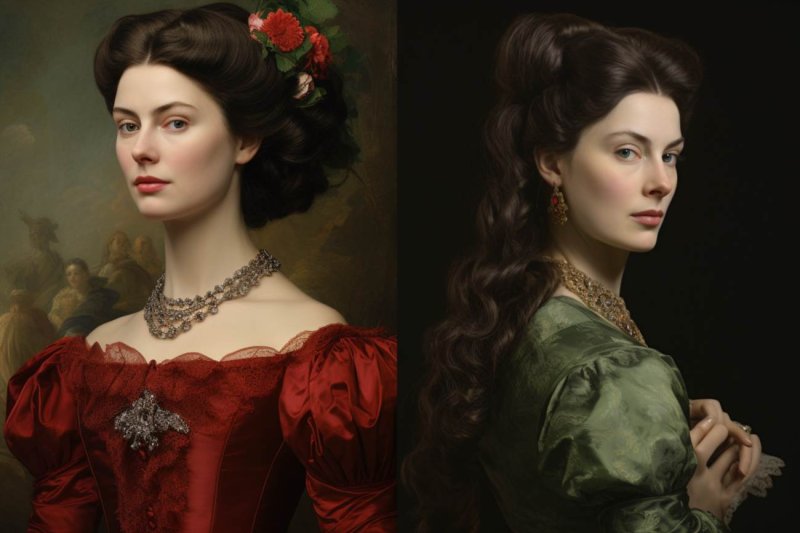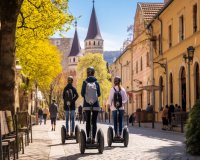Delving into the enthralling life and enduring legacy of Empress Elisabeth.

The Fascinating Life of Empress Elisabeth: More Than Just Sissi
Empress Elisabeth of Austria, often affectionately known as "Sissi," is a historical figure who continues to captivate the imaginations of people worldwide. While she is perhaps most famous for her portrayal in the beloved film series "Sissi" and her beauty, her life was far more complex and intriguing than her cinematic counterpart.
Born on December 24, 1837, in Munich, Bavaria, Elisabeth was the fourth child of Duke Maximilian Joseph in Bavaria and Princess Ludovika of Bavaria. Her full name was Elisabeth Amalie Eugenie, and she would later become known as Empress Elisabeth of Austria and Queen of Hungary.
Elisabeth's early life was marked by tragedy. Her father passed away when she was just a child, and her mother's strict upbringing left a lasting impact on her. However, her beauty did not go unnoticed, and at the age of 15, she married her cousin, Emperor Franz Joseph I of Austria. This marriage would change the course of her life forever.
As Empress of Austria and Queen of Hungary, Elisabeth's life was filled with the responsibilities of her royal duties. Still, she longed for freedom and independence. She was known for her unconventional behavior, which included a strong aversion to court protocol and a love for horseback riding and physical activity.
One of Elisabeth's most enduring legacies is her dedication to beauty and health. She maintained a strict diet and exercise regimen, which was unusual for her time. She was often seen riding and hiking, and she even had a gymnasium built in her palace. Her famous long, flowing hair and slim figure were the envy of many.
Elisabeth's beauty was not limited to her physical appearance. She was an advocate for the beauty of her homeland, Hungary, and played a crucial role in fostering a sense of Hungarian identity within the Austrian Empire. Her support for Hungarian causes endeared her to the Hungarian people, who affectionately called her "Sisi."
Despite her fame and beauty, Elisabeth's life was marred by personal tragedies. The death of her only son, Crown Prince Rudolf, in a murder-suicide pact at Mayerling in 1889, left her devastated. She withdrew from public life, leading a nomadic existence and traveling extensively, often incognito.
Elisabeth's travels took her to many places, including her beloved Hungary and even as far as Egypt and the Greek islands. She developed a deep fascination with the East, and her writings and poetry reflect this interest. She also learned multiple languages, including Greek and Hungarian, to better connect with the cultures she encountered.
Tragically, Elisabeth's life came to a sudden and violent end. On September 10, 1898, while in Geneva, Switzerland, she was assassinated by an Italian anarchist named Luigi Lucheni. Her death shocked the world, and her legacy lives on in the hearts of those who admire her indomitable spirit, love for freedom, and dedication to beauty.
In conclusion, Empress Elisabeth of Austria, known as "Sissi," was more than just a beautiful empress. Her life was a tapestry of complexity, from her royal responsibilities to her love for travel and beauty. She left an indelible mark on history and remains an enduring symbol of grace and independence.
Young Elisabeth and Her Influence on the Austrian Court
Elisabeth of Bavaria, commonly known as Empress Sisi, was born on December 24, 1837, in Munich, Germany. From a young age, she exhibited an independent spirit and a love for the arts, which would later come to shape her identity as a powerful figure within the Austrian Court.
At the tender age of sixteen, Elisabeth married Emperor Franz Joseph I of Austria, marking the beginning of her journey as a prominent figure in European royalty. Her youthful exuberance and charismatic presence breathed new life into the somewhat rigid Austrian Court.
Elisabeth's impact on the Court extended beyond her enchanting demeanor. She was a patron of the arts, supporting musicians, writers, and artists. Her love for poetry and literature was well-known, and she frequently held salons where intellectuals gathered to discuss the latest works and ideas of the time.
One of Elisabeth's most enduring legacies is her dedication to physical fitness and beauty. She was an avid equestrian and spent countless hours riding through the picturesque landscapes of the Austrian countryside. This devotion to a healthy lifestyle was unconventional for a royal of her time and inspired many to follow in her footsteps.
Elisabeth's fashion sense was also revolutionary. She was known for her iconic floor-length hair, which she rarely allowed to be seen in public. Her distinctive style set trends and influenced the fashion of the era. Women across Europe sought to emulate her grace and elegance.
Beyond her external influence, Elisabeth played a crucial role in shaping political affairs. She acted as a mediator between different factions within the Court and used her influence to advocate for causes she believed in, including the rights of the Hungarian people within the Austro-Hungarian Empire.
| Key Contributions of Young Elisabeth: |
| 1. Promotion of the Arts |
| 2. Emphasis on Physical Fitness and Beauty |
| 3. Revolutionary Fashion Sense |
| 4. Political Advocacy |
Tragically, Elisabeth's life was marked by personal hardships, including the untimely death of her son Rudolf and her own assassination in 1898. However, her influence on the Austrian Court endured long after her passing.
In conclusion, Young Elisabeth's impact on the Austrian Court was nothing short of transformative. Her love for the arts, dedication to physical fitness, and advocacy for political causes left an indelible mark on European history. Her legacy continues to inspire generations, reminding us of the power of individuality and the ability to shape the course of nations.
From Budapest: Gödöllő Royal Sissi Guided Tour
Experience a journey from Budapest to Gödöllő, where you'll explore the former summer residence of Queen Elisabeth, affectionately known as Sissi. Marvel at the exquisitely renovated royal palace, the second-largest Baroque chateau in the world.
Your 4-hour tour commences with a scenic drive to Gödöllö, the site of Queen Elisabeth's summer abode. This remarkable palace stands as the world's second-largest Baroque chateau, preserving the opulence of 19th-century royalty.
Guided by a knowledgeable expert, you'll traverse the halls, ascend the staircases, and stroll through the picturesque park, retracing the steps of the Empress of Austria and Queen of Hungary.
The tour culminates at Hotel Intercontinental Budapest, nestled in the heart of the city.
Highlights:
- Explore Gödöllő, the world's second-largest Baroque chateau.
- Admire paintings and photographs of Sissi within the chateau.
- Enjoy a leisurely walk through the castle's tranquil park.
Includes:
- Live guide
- Hotel pick-up (city center hotels)
- Transfer back to the city center
- Air-conditioned bus
- Entrance Ticket
- Hotel drop off
Important Information:
What to bring:
- Comfortable shoes
- Sunglasses
Not allowed:
Know before you go:
- Hotel pick-up is only available in the city center.
- The tour provider is not responsible for road closures.
Language options for live tour guide:
- English
- Spanish
- French
- German
- Italian
Overall rating: 4.3/5 based on 389 reviews
Review summary:
- Guide: 4.6/5
- Transportation: 4.7/5
- Service: 4.3/5
- Organization: 4.4/5
Customer review:
"Had a great time! Paid a little extra for hotel pickup which was totally worth it. Was well organized and the guide did a good job keeping us informed. The palace is beautiful of course and we didn’t feel rushed at all. Our guide split her time between English and German and I think it would have been better to have one dedicated person per language since there were long waits in between when she switched and we didn’t all get all the same facts and she was more comfortable speaking German. The guide did a great job though as switching back and forth would be difficult. Definitely book this tour as it was nice to get out of the city and see a little more of Hungary and to learn why Queen Sisi was so important to the Hungarians."
December 30, 2022
Tiffany – United States
The Travels and Emancipation of Sissi in Budapest
Sissi, also known as Empress Elisabeth of Austria, was a remarkable figure in European history. Her travels and time spent in Budapest played a significant role in her personal development and the broader context of her life. In this article, we will delve into the captivating journey of Sissi and her connection to Budapest.
Sissi: A Brief Introduction
Empress Elisabeth, commonly referred to as Sissi, was born on December 24, 1837, in Munich, Bavaria. She married Emperor Franz Joseph I of Austria at the young age of 16, becoming the Empress of Austria and Queen of Hungary. Her reign as empress was marked by her beauty, intelligence, and independent spirit, making her a beloved figure in history.
The Travels of Sissi
Sissi's life was filled with travel and exploration, driven by her desire for freedom and adventure. Her journeys took her to various European cities, but Budapest held a special place in her heart. The Hungarian capital became a symbol of her quest for emancipation.
One of the most famous landmarks associated with Sissi in Budapest is the iconic Buda Castle. The castle, perched on a hill overlooking the Danube River, offered breathtaking views of the city. Sissi often visited the castle, finding solace and inspiration in its grandeur. The beauty of Budapest's architecture and landscapes left a lasting impression on her.
Emancipation and Influence
Sissi's time in Budapest played a pivotal role in her pursuit of emancipation from the rigid court life of the Habsburg monarchy. She found solace in Hungary's unique culture and its people's warm embrace. Sissi was particularly fond of Hungarian fashion, which she adopted, and she even learned the Hungarian language. Her interest in Hungarian culture endeared her to the Hungarian people.
Moreover, Sissi's influence in matters of state and diplomacy cannot be overlooked. Her support for Hungarian causes and her close relationship with Hungarian nobility helped bridge gaps between the Austrian Empire and Hungary. She played a crucial role in the Austro-Hungarian Compromise of 1867, which established the dual monarchy, transforming Austria into the Austro-Hungarian Empire. This compromise granted Hungary a greater degree of autonomy within the empire, a significant step towards the country's emancipation.
Legacy and Remembrance
Sissi's connection to Budapest continues to be celebrated today. The city's streets, squares, and museums bear her name, preserving her memory. Visitors can explore the Sissi Museum, which houses a collection of her personal belongings, including clothing, jewelry, and letters.
Her story has also been immortalized in literature and film, with various adaptations portraying her life and her deep affinity for Budapest. These artistic renditions have contributed to keeping her legacy alive.
Conclusion
In the heart of Budapest, Sissi found more than just a beautiful city; she found inspiration, emancipation, and a lasting connection with the Hungarian people. Her travels and experiences in Budapest shaped her into the iconic figure she is remembered as today. Empress Elisabeth of Austria, or Sissi, will forever be intertwined with the history and culture of this enchanting European capital.




